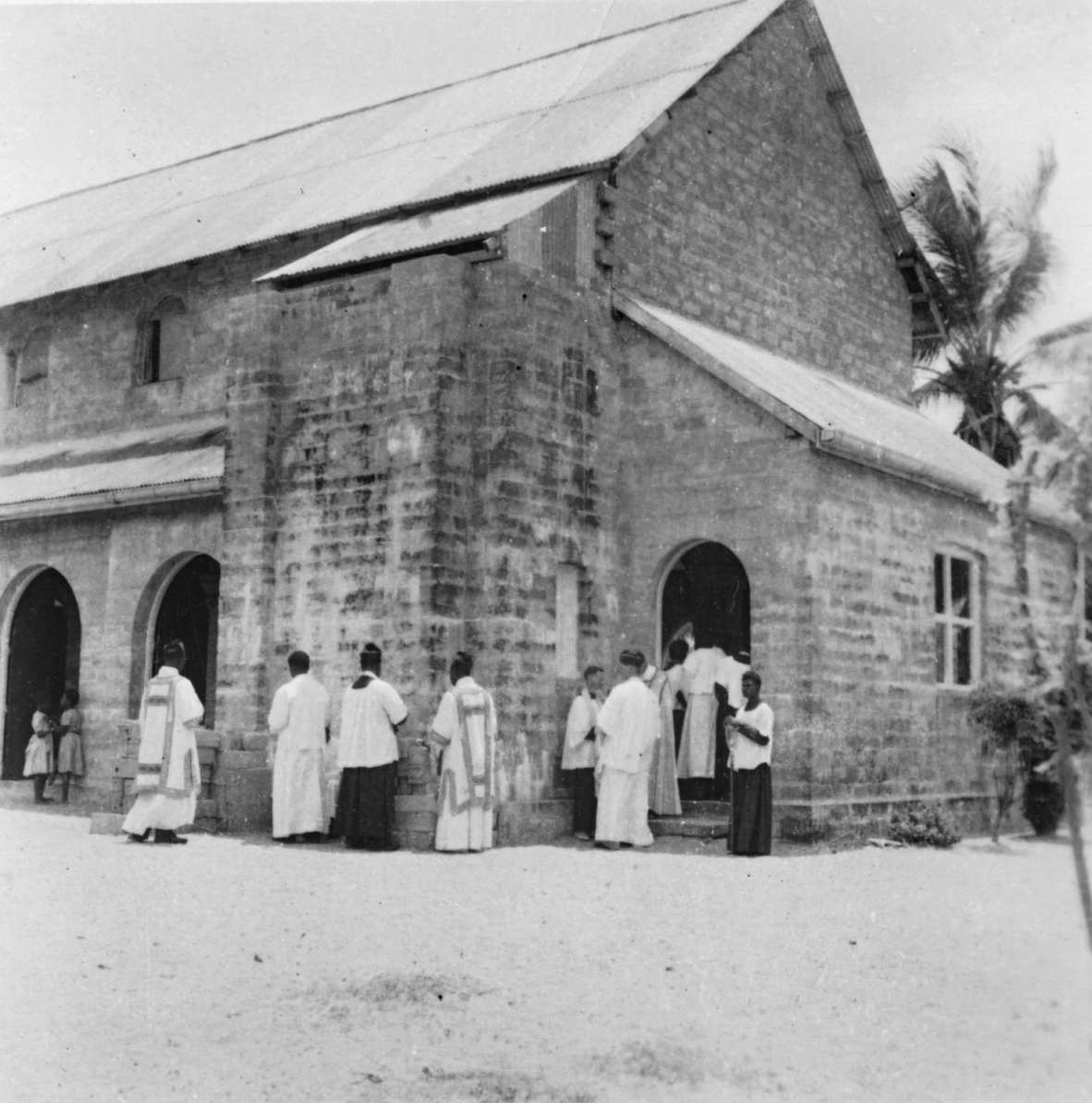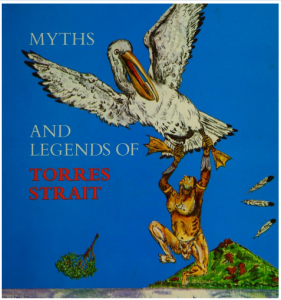Aboriginal and Torres Strait Islander people should be aware that this blog post may contain images or names of Aboriginal people who have passed; this is not meant to cause distress or offence but raise awareness of our shared history and the story of Aboriginal and Torres Strait Islander languages across Queensland.
Welcome to Week Twenty-Nine of the A-Z of Queensland Aboriginal and Torres Strait Islander languages!
This week's language of the week is Torres Strait Creole or Yumplatok as it is also known. Did you know that Torres Strait Creole is the most widely spoken Indigenous language in Queensland, used by over thirty thousand people as a first, second or third language. Linguistically it is classed as a 'new' language which is related to Tok Pisin in New Guinea, Bislama in Vanuatu and Solomon Islands Pijin.

Anglican clergy outside a church in the Torres Strait, 1954.
European arrival, and in particular the establishment of the London Missionary Society (LMS) in the Torres Strait in 1871, saw the beginning of assimilation between Island and western cultures. During this time, Torres Strait Islanders were actively discouraged from speaking traditional languages and practising culture. This resulted in a new language known as Torres Strait Creole, which remains the common language to all Torres Strait Islanders; it has developed from a Pidgin and now has its own distinctive sound system, grammar, vocabulary, usage and meaning. Torres Strait Creole (also known as Ailan Tok or Yumplatok) is spoken by most Torres Strait Islanders and is a mixture of Standard Australian English and traditional languages. It is an English-based creole; however, each island has its' own version of creole.
Torres Strait Creole is also spoken on the Mainland, including Northern Peninsula Area (NPA) and coastal communities such as Cairns, Townsville, Mackay, Rockhampton and Brisbane.

Myths and Legends of the Torres Strait, Margaret Lawrie.
Margaret Lawrie documented stories and songs in Torres Strait Creole - some of these are featured in her 1970 publication Myths and Legends of the Torres Strait. The late Ephraim Bani, a Torres Strait Islander linguist along with community members developed a written system for Torres Strait Creole which saw it being used in a range of materials including books, but also information brochures for Government agencies such as health.
The following is a selection of words in Torres Strait Creole:
-
Father – piip
-
Mother – ama
-
Crocodile – algita
-
Land/Country – lan
-
Sea - malu
-
Sun - san
-
Hello friend = elo met
Torres Strait Creole is used extensively across Queensland - Natasha Hirakawa who works for State Library's Indigenous Library Services, Cairns shares the following:
"Creole has always been my first language. Born on Thursday Island and raised in Cairns, I never lost the language that has kept me connected to my island home. My Mother identifies as Torres Strait/Japanese and my Father of English/Scottish heritage. My Father is an ex-English/Math school teacher and while were expected to read and write 'proper' English, my siblings and I were never denied speaking Creole. Being able to speak and understand Creole to communicate with Indigenous peoples, has enabled me to have a wide range of jobs over my working life. In my current job, working with State Library of Queensland - Indigenous Services, Creole has helped me connect with people in Community and provided a comfortable atmosphere to communicate. Whether I am in a small Community or in a big city, hearing Creole brings a smile to my face and a joy to my heart and I am home".
Thanks Natasha!
Join State Library for next week's Language of the Week - Umbuygamu!
Desmond Crump
Indigenous Languages Coordinator, State Library of Queensland
State Library of Queensland Aboriginal and Torres Strait Islander Languages Webpages
State Library of Queensland Aboriginal and Torres Strait Islander Languages Map
Spoken: Celebrating Queensland languages exhibition
Jarjum Stories exhibition
Minya Birran: What next for Indigenous Languages?
Images
Cover image: Translation of Gospel of Luke into Yumplatok. J 226.4 BIB
Anglican clergy outside a church in the Torres Strait, 1954. 6341 Dr Wilhelm Rechnitz Papers.
Myths and Legends of the Torres Strait, Q 398.2099438 MYT
References and Further Reading
State Library has some material relating to Torres Strait Creole.
Edwards, R. Some songs from the Torres Strait. Q 782.5162 SOM
Edwards, R. (ed) Dictionary of Torres Strait languages. Q 499.1503 RAY
Larry, A. Wis wei y mek-e assis dampa boi = How to make an ashes damper boy. By Anna Larry; illustrated by Ron Edwards. P 641.5929912 LAR
Lawrie, M. Myths and legends of the Torres Strait. Q 398.2099438 MYT
Lawrie, M. The Margaret Lawrie Collection of Torres Straits Materials. TR2082
Mosby, L. Stephens, N and Teske, T. D is for dari : a Torres Strait picture dictionary. P 994.38 MOS
Ray, S. Dictionary of Torres Strait Languages. Q 499.1503 RAY
6341 Dr Wilhelm Rechnitz Papers
Scragg, S. Retold: A retelling of stories and songs from Myths and Legends of the Torres Strait by Margaret Lawrie. DVD 27464
Shnukal, A. A Dictionary of Torres Strait Creole. Q 427.99438 SHN
Yumplatok Translation Committee, Summer Institute of Linguistics (1997) Luk : Yumplatok (Torres Strait Creole). Yumplatok Transleisin Komiti bin transleitem. Translation of Gospel of Luke into Yumplatok. J 226.4 BIB
Comments
Your email address will not be published.
We welcome relevant, respectful comments.